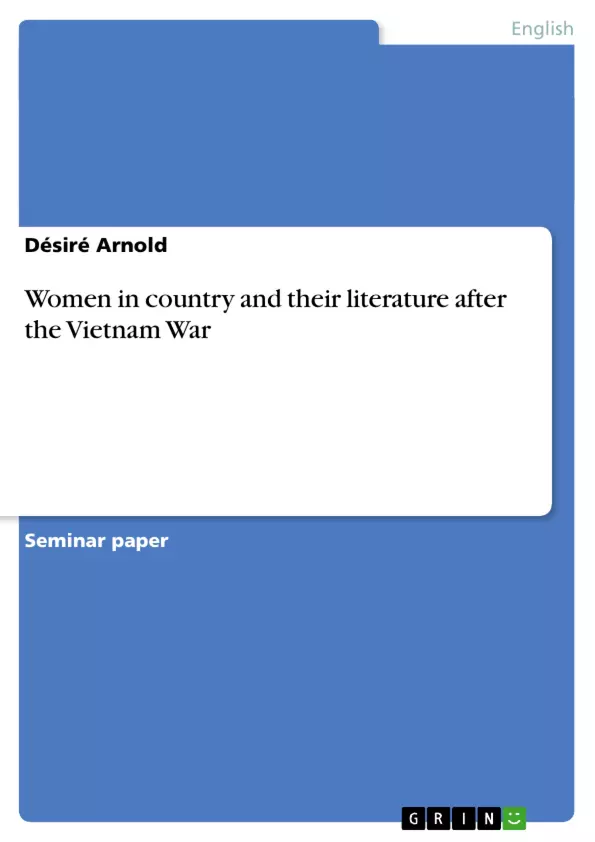The Vietnam War originally was a civil war between the Southern and the Northern part of Vietnam. The USA started being involved in 1954. They tried to support South Vietnam. The Vietnam War ended in 1975, when the communist troops invaded the South Vietnamese city Saigon, the last American soldiers fled and Saigon capitulated without any conditions. The American aim of the war was to combat communism, as the Northern part of Vietnam was communistic. The US government feared more Asian states would fall to communism and similar battles would break out between the states (like the civil war between the two Vietnamese states); if they lost the war in Vietnam, this was called the Domino theory. During the Vietnam War about 7 Million tons of bombs were dropped and other devastations were caused by herbicides, like Agent Orange. During the Vietnam War about 55000 (concrete number below) American soldiers died, half of them weren′t even 21 years old; many of them were blacks and/ or children of a working-class- family. All in all the Vietnam War cost 2,5 Million lives, 90% were civilians of South Vietnam, people that were to be protected by the US soldiers.
But not only men were in Country, "The U.S. Department of Veterans Affairs knows exactly how many men served in Vietnam (2,594,200) and how many were killed in action (58,188). It can furnish all kinds of stats about those soldiers, like the percentage of men who worked in supply (between 60 and 70 percent) as opposed to combat (30 to 40 percent). But ask about the women who served in Vietnam -- women other than nurses -- and the numbers disappear. The records are muddled, they say; the files don′t work that way. Yes, the armed forces sent women to Vietnam, but an official record of their presence there doesn′t really exist. At least 1,200 female soldiers were stationed in Vietnam in various branches of the military as photojournalists, clerks, typists, intelligence officers, translators, flight controllers, even band leaders. They served prominently in Saigon, in the Mekong Delta and at Long Binh, which was, for a time, the largest Army headquarters in the world. They could not fight, nor were they allowed to carry weapons to defend themselves. Most were part of the pioneering Women′s Army Corps (WAC), created in 1942 to integrate the armed forces. All of them enlisted for service in Vietnam, mostly in the early part of the war. Like a lot of Vietnam veterans, these women have been dogged by their experiences in country; unlike many veterans, they do not feel officially recognized and have been reluctant to seek help. Some have been plagued by symptoms of post-traumatic stress syndrome and exposure to chemicals. Others have harbored the fact of their service like a shameful secret." (Bunn) "Women served in Vietnam in many support staff assignments, in hospitals, crewed on medical evacuation flights, with MASH Units, hospital ships, operations groups, information offices, service clubs, headquarters offices, and numerous other clerical, medical, intelligence and personnel positions.
Inhaltsverzeichnis (Table of Contents)
- 'Hello David' introductory poem by Dusty
- The Vietnam War
- General Aspects
- Women
- Literary Approaches
- Poetry
- Dusty
- Dusty Herself
- Her poem ‘Like Emily Dickinson'
- Emily
- Emily Herself
- Her poem 'kenny'
- Dusty
- Short Stories
- Dusty 'Welcome Home I'
- Poetry
- Bibliography
- Books
- Online Sources
- Additional Texts for reading
- ‘Please forgive me'
- 'Playing Games'
Zielsetzung und Themenschwerpunkte (Objectives and Key Themes)
This work aims to examine the experiences of women in Vietnam and their contribution to the literature that emerged following the Vietnam War. It explores the diverse roles women played during the conflict and the impact their experiences had on their creative output. * The Vietnam War and its historical context, including the involvement of the USA and the experiences of women during the conflict. * The literary approaches of women writers who experienced the Vietnam War, particularly in poetry and short stories. * The representation of women's voices and perspectives in the literature of the post-Vietnam War era. * The challenges and recognition faced by female veterans, including their experiences of trauma, the lack of official recognition, and the importance of their stories. * The exploration of themes of love, loss, and resilience in the context of war and its aftermath.Zusammenfassung der Kapitel (Chapter Summaries)
- The chapter titled "‘Hello, David' introductory poem by Dusty" presents the poem itself, exploring the themes of loss, grief, and the role of a nurse in a war-torn setting.
- The chapter "The Vietnam War" delves into the historical context of the conflict, highlighting the involvement of the USA, the reasons for the war, and the devastating consequences for both Vietnamese civilians and American soldiers. It also discusses the specific experiences of women during the war, emphasizing their largely unrecorded and often unrecognized roles.
- "Literary Approaches" focuses on the ways in which women writers have explored their Vietnam War experiences through poetry and short stories. It highlights the works of Dusty and Emily, examining their individual styles and the themes that emerge in their writing.
Schlüsselwörter (Keywords)
This work focuses on the themes of women in Vietnam, post-war literature, poetry, short stories, the role of women in war, trauma, resilience, and the recognition of female veterans. Other key terms include the Vietnam War, the Domino Theory, Agent Orange, and the Women's Army Corps (WAC).- Quote paper
- Désiré Arnold (Author), 2003, Women in country and their literature after the Vietnam War, Munich, GRIN Verlag, https://www.grin.com/document/22513



